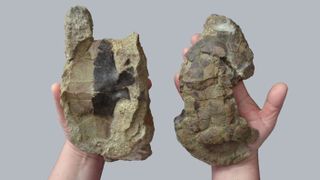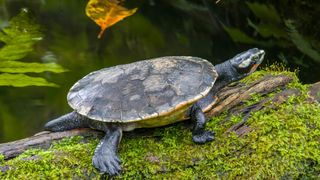Ancient Transylvanian turtle survived the extinction of the dinosaurs
The turtles' freshwater habitat may have helped them survive.

A 70 million-year-old fossil unearthed in Transylvania is a newfound species of freshwater turtle that likely survived the extinction event that wiped out the nonavian dinosaurs.
Researchers initially found the reptilian fossil at a site called Haţeg Basin in Romania in the 1990s. The remains include near-complete sections of the turtle's carapace (upper shell) and plastron (lower shell), as well as a bone from one of its arms and another from its pelvis. Based on these body parts, the researchers estimated that the turtle would have had a body length of around 7.5 inches (19 centimeters), they reported in a new study. The team named the new species Dortoka vremiri in honor of Mátyás Vremir, an expert in Cretaceous vertebrates who died in 2020.
D. vremiri belongs to a group of turtles known as side-necked turtles, of which there are 16 living species found in South America, Africa and Australia. Fossils of a similar species that likely descended from D. vremiri date back to around 57 million years ago, which suggests that D. vremiri survived the end-Cretaceous extinction event that wiped out around 75% of all life on Earth.
Related: 10 coolest non-dinosaur fossils unearthed in 2021
"Intriguingly, members of the same family of turtles did not survive this extinction event in western Europe," lead author Felix Augustin, a doctoral student at the University of Tübingen in Germany, said in a statement. The newfound species' geographic range and freshwater habitat likely helped it survive when its relatives and most terrestrial species could not, the researchers said.
The researchers think that, during the Cretaceous period (145 million to 66 million years ago), the Haţeg Basin was likely a separate island that later merged with Eastern Europe. This island could have somewhat isolated D. vremiri from the ecological destruction caused by the falling asteroid, Augustin said in the statement.

However, a previously discovered ancient tortoise, Kallokibotion bajazidi, which experts believe shared the island with D. vremiri during the late Cretaceous, did go extinct along with the dinosaurs. "This fits a previously observed pattern from North American faunas where terrestrial vertebrates were notably more impacted by the end-Cretaceous extinction than freshwater species," co-author Zoltan Csiki-Sava, a paleontologist at the University of Bucharest in Romania, said in the statement.
Sign up for the Live Science daily newsletter now
Get the world’s most fascinating discoveries delivered straight to your inbox.
Freshwater food chains rely on decaying organic matter in the water, which would have continued to remain abundant, or potentially even increased, during the end-Cretaceous extinction event. However, the base of the terrestrial food web is plants, and around half of plant species on Earth were killed off by either massive wildfires set off by the crash or reduced sunlight from a period of global dimming that followed the initial impact, and limited their ability to photosynthesize. This difference in food availability is what allowed D. vremiri to outlive its terrestrial counterpart, the researchers said in the statement.
In May 2021, paleontologists in Madagascar discovered another Cretaceous freshwater side-necked turtle that they also suspect survived the mass extinction event before later becoming extinct, Live Science previously reported.
Evidence of freshwater ecosystems being more resilient than terrestrial ecosystems to extinction events remains rare, but findings like those in the new study could provide clues as to how freshwater species could fare when faced with upcoming ecological crisis caused by human activity such as climate change, senior author Márton Rabi said in the statement.
The study was published online Feb. 8 in the Journal of Systematic Palaeontology.
Originally published on Live Science.

Harry is a U.K.-based senior staff writer at Live Science. He studied marine biology at the University of Exeter before training to become a journalist. He covers a wide range of topics including space exploration, planetary science, space weather, climate change, animal behavior, evolution and paleontology. His feature on the upcoming solar maximum was shortlisted in the "top scoop" category at the National Council for the Training of Journalists (NCTJ) Awards for Excellence in 2023.
Most Popular



